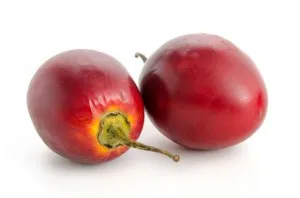
- Share on Facebook44
- Share on Pinterest
- Share on Twitter
The tree tomato, also known as the tamarillo, is a member of the nightshade family, just like the regular tomato. It is thought to have originated in the high altitude forests of the Andes of Brazil and Peru in South America. Today, it’s cultivated in many of the worlds subtropical regions and on a commercial scale in large orchards found in northern regions of New Zealand, exported to the U.S., Australia, Europe and Japan.
Tamarillos have an oval shape and smooth, shiny skin and can be different colors depending on the variety, but red is more common than orange-yellow types.
The tree tomato is very low in calories. One medium fruit contains just 22 calories yet it’s packed with beneficial nutrients, including dietary fiber, minerals and antioxidants. Its antioxidant content is largely derived from polyphenolic, flavonol and anthocyanidin compounds, with phytochemicals that include chlorogenic acid which is believed to help lower blood sugar levels in people with type 2 diabetes.
Tamarillos also offer antioxidant properties that, combined with their vitamin A content, help support eye health as well as maintaining healthy skin and protection from lung and oral cancers.
The fruit also contains the carotenoids known as lycopene and beta carotene. Lycopene is well known to help fight free radicals which are the root cause of a wide range of chronic disease and illness. Along with lycopene and beta carotene, tamarillos contain lutein and zeaxanthin, which can help protect and repair cells against DNA damage, preventing premature aging.
Tamarillos are a good source of potassium too, which is important for controlling the heart rate and blood pressure.
 You can use the tamarillo as you would a tomato in just about any recipe, but keep in mind that its tough skin is inedible, so it will need to be peeled first. To make the skin easier to remove, you can blanch it in boiling water, followed by shocking it in ice water. It can be eaten raw, however, it is extremely acidic so it is best eaten with a sprinkling of sea salt. Just scoop out the pulp and enjoy the flesh, the flavor is comparable to plum, gooseberry and tomato.
You can use the tamarillo as you would a tomato in just about any recipe, but keep in mind that its tough skin is inedible, so it will need to be peeled first. To make the skin easier to remove, you can blanch it in boiling water, followed by shocking it in ice water. It can be eaten raw, however, it is extremely acidic so it is best eaten with a sprinkling of sea salt. Just scoop out the pulp and enjoy the flesh, the flavor is comparable to plum, gooseberry and tomato.
A few ideas for using tamarillos include:
- Make a tomato-like sauce, salsa or curry replacing them with the same amount of tomatoes.
- Bake or grill them like you would vegetables.
- Add whole, peeled tamarillos to a casserole.
- Toss peeled, sliced tamarillos into your salad.
- Tamarillos also make great jams, preserves, jellies, relishes and marmalades.
You might even have a little fun with it by getting creative and coming up with your own, original recipe using the tamarillo. Enjoy, to your good health!
-The Alternative Daily
Sources:
http://www.calorieking.com/foods/calories-in-fresh-fruits-tamarillo-raw-peeled_f-ZmlkPTEzNDU2Mw.html
http://www.hindawi.com/journals/jo/2012/271063
http://www.nutrition-and-you.com/tamarillo.html
http://www.tamarillo.com/things_to_try
https://food-nutrition.knoji.com/tamarillo-or-tree-tomato-its-nutrition-and-gastronomical-uses
- Share on Facebook44
- Share on Pinterest
- Share on Twitter

